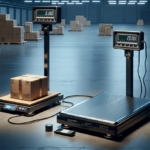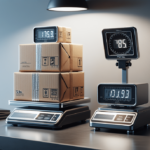Comparing Salter Brecknell LPS-400 and Accuteck ShipPro W-8580 Shipping Scales
Accurate and efficient weighing scales are essential for businesses that rely on shipping to operate smoothly. Among the top contenders in the market are the Salter Brecknell LPS-400 and the Accuteck ShipPro W-8580. This comprehensive comparison examines these scales based on design, capacity, accuracy, display features, ease of use, power source, software compatibility, pricing, and customer feedback to help you determine which scale best suits your business needs.
Key Features and Specifications
Design and Build Quality
The Salter Brecknell LPS-400 features a robust stainless steel top, offering durability and a professional appearance. Its larger platform size of 15.75" x 19.75" accommodates bulkier packages, making it ideal for businesses handling large shipments.
In contrast, the Accuteck ShipPro W-8580 is designed with portability in mind, featuring a lightweight plastic top and a compact platform of 8" x 8". This makes it suitable for businesses with limited space or those needing to move the scale frequently.
- Salter Brecknell LPS-400:
- Stainless steel top for enhanced durability
- Backlit LCD display for visibility in low light
- Larger weighing platform (15.75" x 19.75")
- Accuteck ShipPro W-8580:
- Plastic top for lightweight portability
- Detachable display for flexible placement
- Smaller weighing platform (8" x 8")
Capacity and Accuracy
When it comes to capacity and accuracy, both scales offer impressive specifications tailored to different business needs.
- Salter Brecknell LPS-400:
- Maximum capacity: 400 lbs
- Accuracy: ±0.1 lbs
- Suitable for large and bulk shipments
- Accuteck ShipPro W-8580:
- Maximum capacity: 110 lbs
- Accuracy: ±0.1 oz
- Ideal for smaller, lighter packages
Both models support multiple units of measurement, including pounds, ounces, kilograms, and grams, which is essential for businesses dealing with international shipping standards.
Display Features
The display is a vital component of any shipping scale, influencing readability and user experience.
- Salter Brecknell LPS-400:
- Large, backlit LCD screen for easy reading in various lighting conditions
- Displays tare weight and individual package numbers
- Accuteck ShipPro W-8580:
- Smaller LCD display without backlighting
- Detachable display for flexible mounting options
Ease of Use
User-friendly interfaces and intuitive controls can significantly enhance the efficiency of shipping operations.
- Salter Brecknell LPS-400:
- Four large, accessible buttons operable with gloves
- Built-in handle for easy relocation
- Accuteck ShipPro W-8580:
- Touch control panel for straightforward operation
- Lightweight and portable design for frequent movement
Power Source
Power efficiency is crucial for minimizing operational costs and ensuring uninterrupted use.
- Salter Brecknell LPS-400:
- Powered by two AAA batteries
- Battery life up to 90 hours
- Automatic shutoff feature to conserve power
- Accuteck ShipPro W-8580:
- Powered by four AA batteries or an AC adapter
- Battery life up to 60 hours
- Higher battery consumption due to additional features
Software Compatibility and Integration
Efficient shipping operations often require seamless integration with shipping software to automate and streamline processes.
- Salter Brecknell LPS-400:
- Compatible with major shipping software platforms like UPS WorldShip, QuickBooks, and FedEx Ship Manager
- Supports data transfer via USB for easy integration with computers and other devices
- Accuteck ShipPro W-8580:
- Supports integration with select shipping software platforms
- Includes a built-in USB port for data transfer
While both scales offer software compatibility, the LPS-400 provides broader integration options, making it a more versatile choice for businesses utilizing multiple shipping software solutions.
Pricing and Value for Money
Price is a critical factor when selecting a shipping scale, balancing cost with features and performance.
- Salter Brecknell LPS-400:
- Approximate price: $230
- Higher cost justified by larger capacity and extensive feature set
- Accuteck ShipPro W-8580:
- Approximate price: $25
- Affordable option for small businesses or individuals
- Lower cost comes with reduced weight capacity and fewer features
Customer Feedback and Reviews
Understanding real-world user experiences can provide valuable insights into the performance and reliability of these scales.
- Salter Brecknell LPS-400:
- Pros: High accuracy, substantial weight capacity, broad software compatibility
- Cons: Larger platform may not suit limited spaces, higher price point
- Accuteck ShipPro W-8580:
- Pros: Affordable, easy to use, highly portable
- Cons: Limited weight capacity, sensitive touch controls
Overall, the Salter Brecknell LPS-400 is lauded for its reliability and versatility, making it a preferred choice for businesses with diverse shipping needs. Meanwhile, the Accuteck ShipPro W-8580 receives high marks for its cost-effectiveness and ease of portability, ideal for smaller operations.
Recommendations for Different Business Sizes
Best Scale for Small Businesses
For small businesses, the Accuteck ShipPro W-8580 emerges as the superior option due to its affordability and portability. Its lightweight design and intuitive controls make it perfect for businesses with limited space and budget constraints.
However, if a small business anticipates handling larger packages occasionally, investing in the Salter Brecknell LPS-400 may offer greater flexibility despite the higher initial cost.
Best Scale for Large Businesses
Large businesses, which require robust and versatile shipping solutions, would benefit more from the Salter Brecknell LPS-400. Its high weight capacity, extensive software compatibility, and durable construction make it well-suited for high-volume shipping environments.
The investment in the LPS-400 is justified by its advanced features and reliability, ensuring accurate and efficient shipping processes critical for larger operations.
Final Verdict: Choosing the Right Shipping Scale
Deciding between the Salter Brecknell LPS-400 and the Accuteck ShipPro W-8580 hinges on your business's specific requirements:
- Choose the Salter Brecknell LPS-400 if:
- Your business handles large or bulky packages regularly
- You require high accuracy and extensive software compatibility
- Durability and reliability are top priorities
- Choose the Accuteck ShipPro W-8580 if:
- You operate a small business with limited shipping volumes
- You need a cost-effective and portable solution
- Space constraints necessitate a compact design
Both scales offer precise measurements and user-friendly features, catering to a wide range of shipping needs. Assessing your business operations and shipping requirements will guide you to the most suitable choice.
Conclusion: Key Factors to Consider When Selecting a Shipping Scale
Selecting the right shipping scale is crucial for maintaining efficiency and accuracy in your shipping operations. Consider the following factors to ensure the scale aligns with your business needs:
- Business Size: Larger businesses may require scales with higher weight capacities and greater durability, while small businesses might prioritize affordability and portability.
- Weight Capacity: Determine the maximum weight of packages you typically handle to choose a scale that meets your needs.
- Accuracy: Ensure the scale provides precise measurements to avoid shipping errors and additional costs.
- Software Compatibility: Opt for a scale that integrates seamlessly with your existing shipping software to streamline operations.
- Portability: If your operations require moving the scale frequently, a lightweight and portable model is essential.
- Budget: Balance the scale's features and performance with its cost to find the best value for your investment.
Investing in a high-quality, reliable shipping scale tailored to your business operations will enhance shipping accuracy and efficiency, ultimately contributing to customer satisfaction and operational success.
Enhancing Shipping Accuracy: Best Practices
To maximize the accuracy and reliability of your shipping scale, implement the following best practices:
- Stable Placement: Ensure the scale is placed on a flat, stable surface to prevent inaccuracies caused by uneven flooring.
- Regular Calibration: Periodically calibrate the scale according to the manufacturer’s instructions to maintain precision.
- Cleanliness: Keep the scale free from dust, debris, and packaging materials that could interfere with weight readings.
- Use Tare Function: Utilize the tare feature to exclude the weight of containers or packaging materials, ensuring only the product weight is measured.
- Consistent Packaging: Use uniform packaging materials to minimize variations in weight that could affect shipping costs.
Adhering to these practices will ensure your shipping scale operates accurately, reducing the risk of shipping errors and additional costs associated with incorrect weight measurements.






















